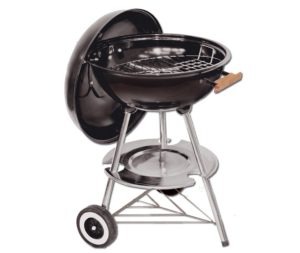 The kettle grill is a charcoal grill invented by George Stephen in 1951. It is one of the most popular charcoal grill designs to date. It is composed of a lid, cooking grid, charcoal grid, lower charcoal chamber or bowl, venting system, and frame or legs. The lower chamber where the charcoal is placed is dome-shaped, like a kettle, hence its name.
The kettle grill is a charcoal grill invented by George Stephen in 1951. It is one of the most popular charcoal grill designs to date. It is composed of a lid, cooking grid, charcoal grid, lower charcoal chamber or bowl, venting system, and frame or legs. The lower chamber where the charcoal is placed is dome-shaped, like a kettle, hence its name.
The charcoal bowl and lid are typically porcelain-enameled while the legs or frames are made from heavy-duty steel. Other parts are usually made from aluminum or steel. Kettle grills come in a variety of sizes including the smaller tabletop models and the free-standing types. Larger models usually have wheels or caster for portability.
When shipping a kettle grill, proper packing precautions must be observed to ensure that it arrives without dents or scratches on its enameled finish. Here are some tips on how to properly pack and ship a kettle grill to make sure that it arrives in excellent condition.
Get a sturdy shipping box that is at least 2 inches larger than the kettle itself. Cut to size rigid foam and lay on the bottom of the box. Place the grates and grids on top of the foam and lay another layer of rigid foam.
Wrap the kettle bowl in bubble wrap, paying extra attention to the protruding handles, and place it inside the box. The handles should be positioned facing the corners of the box and not against the sides to prevent them from damaging the box. Wrap the ash catcher with bubble wrap and place it inside the bowl.
Bubble wrap the lid as well and place, upside down, into the bowl. Make sure that no metal surfaces are in contact. Then, fill all voids inside the box with as many packaging materials (bubble wrap, peanuts, or crumpled newspaper) as you can. Finish it off with another sheet of rigid foam on top of the lid.
If the box has extra space on top, you can either fill it with more packing materials or cut down the corners and fold over the extra cardboard. Make sure that the box is tightly packed and the kettle grill inside does not move or shift before closing it and sealing it with heavy-duty packaging tape.
Address and label the package and take to your local post office or shipping company.
